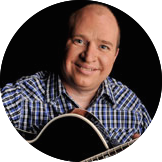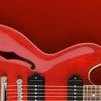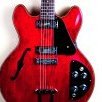
Triple-o
Members-
Posts
538 -
Joined
-
Last visited
-
Days Won
29
Content Type
Profiles
Forums
Gallery
Events
Articles
Blogs
Downloads
Everything posted by Triple-o
-
Thanks, you know for being one of the most popular songs ever written I really should learn it.The 144 bpm Is pretty fast, maybe that’s why it’s on a space capsule.🤣. You know if Chuck Berry wouldn’t have changed one word in the song we may never had hear the song. In your other post you mentioned tuning pegs. I hear tell they are better on classical guitars, than machine heads, because the strings actually touch the wood headstock which Improves the sound.
-
I notice in the song hits it’s played at 130 bpm.That is fast with no room for error. Now I learn that the song is actually played at 152 bpm. The only thing I can say to that is “I don’t believe it, it’s not the truth, no one can pick as fast as that” yeah yeah yeah.
-
Thanks, like in the song “Oh Pretty Women“ ( Original version) after the first 4 bars the following 4 bars are a riff and that riff is repeated again in the song.
-
What can I to practice today that might help me? I was putting some bird seed out and I thought wasn’t there a band called “The Birds”. I was close, but no cigar. Since Birds is slang for girls and Roger McGuinn didn’t want his band to be called “The Girls” he changed the spelling to “The Byrds”. Thanksgiving dinner also is involved and that part you could probably guess. Were they at the time “America’s Beatles”? Some thought they were.Jim later also changed his name to Roger, why you ask, afraid you’ll need talk to his guru. I think a 12 string Rickenbacker also has a story to tell if your interested. I stumbled across a Pete Seeger song they did. Turn Turn Turn. A song Pete Seeger apparently took straight from the scriptures. I looked at a few lessons on YouTube sites and it looks like it might be worth the time to play around with it for awhile. Some hybrid picking, easy strumming patterns and arpeggios come into play along with a few chords I haven’t played before and a catchy intro riff. So, I guess I’ll give give it a try.
-
I took the fishman to an electrician who works as a amp repair guy for a guitar store. He had it for two months and he couldn’t fix it. So, I called fishman and shipped it to them. Within a week I got it back, but it wasn’t the same one I had sent them. It was brand new. Really surprised since the amp wasn’t under any warranty and was about 5 years old.
-
How do you personally play with chord. Do you curve your barre finger so that it mutes the A? The chord is part of a Dsus2 ,G6 and Bm7/D Progression, first position. edit, I think I figured it out, mute the G string with your pinky.
-
I think I understand . It’s just a quick bend, bend up and mute. (Bend up and choke) chock bend. The source was just using a bend terminology I hadn’t hear before and I assumed it was something new. The rhythmic structure really determines the duration of the bend
-
I was thinking that a riff has chords and could also contain single notes and licks only single notes.
-
Imagine, living in a yellow submarine in a sea of green, well maybe not the Wadden Sea. The Beatles song “Yellow Submarine” has been on my mind lately because It doesn’t seem to fit with the rest of their music. So, what drugs were they taking and what does a yellow submarine really represent? There has to be a secret meaning. So, I new I had to hear the song played in reverse, WOW! What a surprise. My ears glued to the speaker I listened to every sound and yes it was all there, gibberish, no message in a bottle, nothing but gibberish.There probably were no drugs involved in writing the song. So, Paul wasn’t lying when he said, “it’s a children’s song” nothing more. I would suggest you go to Justin’s guitar site and watch his lesson..Its a pretty good beginner song and if you have kids or grandchildren it may be just the song.
-
Until I heard Steve play a turnaround and call it a lick I thought turnarounds were something different. I guess some licks just make better turnarounds. Then he caused me more confusion by saying licks and riffs were the same. I guess it’s like trying to figure out, at high tide, where the North Sea ends and the Wadden sea begins.i guess when I get my “Yellow Submarine” I’ll find out.
-
Another symbol I haven’t seen before is the one for a choke bend. A “vertical line then short horizontal line” used when a grace note is involved or an upside down V over the notes without grace note. Bend and immediately mute with your fretting hand. I find that there is a no standard for some symbols and only a “song book notation legend” can clear up any confusion.
-
No, this post is not about Corvid -19, but the virus is also really kind of a drag. “It really is kind of a drag” is a line from the Led Zeppelin song “Since I’ve been loving you”. Another song I never heard before. I know, I know, you must think I am the last Neanderthal living in some cave in Germany or France. Although, I do wish I had one of those “evolution guitar tee shirts” When looking at the song’s sheet music, a short vertical wavy line with an arrow head immediately caught my eye. I’ve seen a long wavy line before and I new that it meant to “play like a harp” one note at a time slowly, Quasi-Arpi. (Mel bay method books) This line was short with the an arrow head next to what looked like a double stop. Well, turns out it’s the symbol for an arpeggio. Ten years of practice and I never came across this symbol with an arrow head, and usually the arpeggios I seen aren’t written like a chord. I also see there is a bracket symbol used next to chord notation that means not arpeggiated. Just in case you’re working on session 11, pentatonic scales, you might want to look at this slow jazzy blues rock in Eb (Cm pentatonic). It looks like a good one to practice the Cm pentatonic scale with the Gb from the Eb blues scale.
- 1 reply
-
- 1
-

-
K pol or cap pol, Depending on whether you water your flowers with a hose or hose pipe.I finally decided it was time to figure these things out. I was under the impression that if you knew barre chords they weren’t of much use. Well, as usual I was wrong again. Found a good article in May June 2019 Acoustic Guitar magazine. You can find the article on line.
-
Mull of Kintyre, a song with simple chords and equally easy strumming style. Not sure why I never heard this song before.Anyway it is my intro into trying to sing and strum. Not an easy task, but after.about an hour I see it’s not as daunting as I thought it would be. So, “like a mist rolling in from the sea” I will take it slow and give it a shot.A few minutes a day out of my practice schedule shouldn’t “kill“ me. So, if you’re new to the guitar, take a look at this song. With the chords A D and E you can’t go wrong with this beginner song.
-
Usually what folks are told to do is move up the neck to where you can play the shape you want, then gradually start moving down the neck to the correct location. I can also remember reading where old timers would sleep with spacers between their fingers to help their finger stretch. Tough chord, I’ve often wondered if I had the correct scale length guitar.
-
Tell me it’s not true and that Steve was only joking when he said he doesn’t know the song Colorado Christmas🎅 P.S. Do I dare ask about “Moon over My Hammy”
-
“You stop growing on the guitar when you quit exploring” Phil Keaggy “Practice until you prove you can’t play” Les Paul
-
I’ve noticed over the years that members have asked about when to start the fingerstyle course.The answers always seemed to be about the same, after session 10 or when you can play barre chords. I am beginning to think that you can start anytime. There is plenty of material that you can play that doesn’t require barre chords. It just seems to that it would help in gaining hand dexterity. There are also many interesting exercises that would help you in the main course. Session 3 for example has you spending more time on 3rds 6ths and 10ths. It also has 3 or 4 songs, one of which is Steve’s arraignment of Blackbird.
-
I wish I could try out some smaller fingers.
-
I am starting to realize that I do press to hard. The indentations really do seem to be too deep.Just another thing that requires my attention.
-
Most of the time I don’t mute other strings.Then there are times when my fingers get at a angle to the string that causes problem. I notice in fingerstyle playing that every mistakes seems to be multiplied and string vibrations also becomes a factor. Yea, It would be nice if one could exchange poorly designed fingers and thumbs.I notice that most women have a longer index finger than their ring finger. I always wondered if that gave them an edge when playing.
-
Glad to hear from someone with larger fingers than myself.
-
When you fret a note how close to your fingernail is the string? When I look at the indentation made on my fingers it is about 3/16 from the nail. I am beginning to think, in my case, it’s too far. How many of you wear a size 14 or larger ring on your ring finger?
-
I’ve heard some folks refer to simile marks as percentage signs, but like you I have never seen the percentage (%) used. I assumed the % was used in this thread because it was close to what simile marks look like and the author was limited to the keyboard, The double %% used would be very misleading.






